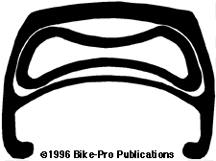

There are two note worthy rim makers in Japan, Araya and Ukai. They are note worthy because each of them has had their rims sold as original equipment on new bicycles and at one point both had their rims sold in the US as after market replacement parts. Both are well known for excellent quality and workmanship, however, at the moment, only Araya seems to have rims available in the US for after market replacements.
Ukai's participation in the United States parts distribution system dropped off beginning in the fall of 1987, after the G7 meeting drove the value of the dollar down and Japanese goods edged their way toward double the Yen price. Ukai is reported to have been the maker of the Specialized and also made the Ritchey rims that are sold on new bikes as original equipment. The Ukai manufactured Ritchey rims can be identified bt their welded rather than sleeved joint.
Right: Sectional View of Araya joint.
Both of these rim makers sell their goods through importer/distributors who have to make a value judgement in terms of what they think will sell to retailers in a reasonable period of time. The importer/distributor then places an order through a Japanese export trading company for delivery 90 to 120 days in the future. If they predict wrong they will have an overstock, tying up their capital. By nature, these organizations, when it comes to bulky items like rims, buy very conservatively which leads to occasional stateside shortages of either models, colors, or drillings.
The CTL-385 is was introduced in the 1992 model year. Araya makes it available to importer/distributors in both a 700c and 26" diameters, though we have seen it in the United States only in the 700c diameter. The CTL-385 has double wall construction, using a Box shape extrusion with slightly convex, (sloping outward) side wall. The lower wall of the extrusion, the spoke bed, is made slightly thicker than the side and the cross-tie walls, though the CTL-385 uses eyelets to equalize the spoke nipple stress.
Once the extrusion has been rolled into the hoop shape, the ends are joined using an aluminum insert into the cavity between the cross-tie and spoke bed walls of the rim. It uses the rim ends as a "sleeve" to hold and retain the inner aluminum core with a steel eyelet passing through the insert at both sides of the joint. We found the ends joined very smoothly on the specimen we wrote about. After joining the ends, the rim is anodized and the spoke and valve holes are drilled. The CTL-385 uses one-piece, double wall steel eyelets to prevent spoke nipple pull through rim failure.
The eyelet piece is stamped from sheet steel, forming the upper cup and flange shape, while the bottom eyelet piece takes the form of a hollow rivet. The eyelet is inserted into the rim from the interior or tire facing side of the cross-tie wall with the tubular rivet exposed through the spoke bed wall. Force is applied to the top of the rivet, so a mandrel at the hub facing side of the spoke bed wall can flare the lower rivet into a smooth round blossom that now holds the eyelet in place.
The spoke bed wall on the CTL-385 showed no post machining distortion from this peening process. We sell the CTL-385 rim in the 700c diameter with 32 or 36 spoke holes and a Presta valve drilling with a Silver or hard anodized Grey finish.
CTL-385 700C x 32 hole (Color-GY-S). CTL-385 700C x 36 hole (Color-GY-S)
For more specifics, please consult the Rim table.
Rim Prices
ARAYA 395 TEAM
